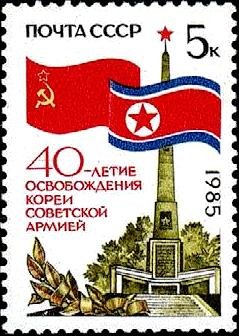Stamp: 40th Anniversary of Liberation of Korea. (Soviet Union, USSR 1985)
40th Anniversary of Liberation of Korea. (Soviet Union, USSR 1985)
01 January (Soviet Union, USSR ) within release 10th Anniversary of Independence of Angola. goes into circulation Stamp 40th Anniversary of Liberation of Korea. face value 5 Russian kopek
| Stamp 40th Anniversary of Liberation of Korea. in catalogues | |
|---|---|
| Michel: | Mi:SU 5536 |
Stamp is vertical format.
Also in the issue 10th Anniversary of Independence of Angola.:
- Stamp - 40th Anniversary of Liberation of Korea. face value 5;
- Stamp - th Anniversary of "Pionerskaya Pravda" newspaper face value 5;
- Stamp - "The count-duke of Olivares", by Diego Velazquez, 1637/38 face value 50;
- Mini Sheet - World Fair "Expo-85" in Japan. face value 40;
- Mini Sheet - 40th Anniversary of Victory in Second World War. face value 40;
- Stamp - Millenary of Bryansk. face value 5;
- Mini Sheet - 12th World Youth and Students' Festival. face value 40;
- Stamp - 115th Birth Anniversary of V.I.Lenin. face value 5;
- Stamp - 30th Anniversary of Warsaw Pact Organization face value 5;
- Stamp - 80th Birth Anniversary of Mikhail Aleksandrovich Sholokhov face value 5;
- Stamp - Locomotives and Rolling Stocks. face value 80;
- Mini Sheet - Space Research. face value 90;
- Mini Sheet - Space Flight of "Soyuz T-12" face value 80;
- Stamp - 50th Anniversary of Stakhanov Movement. face value 5;
- Stamp - 40th Anniversary of Vietnamese Independence. face value 5;
- Stamp - Birth Centenary of S. V. Gerasimov face value 5;
- Stamp - 68th Anniversary of October Revolution. face value 5;
- Stamp - 40th Anniversary of UNO. face value 15;
- Stamp - 150th Birth Anniversary of K.Yu.Baron. face value 5;
- Stamp - 10th Anniversary of Independence of Angola. face value 5;
- Mini Sheet - Happy New Year. face value 8*5;
- Stamp - 70th Birth Anniversary of N.M.Emanuel. face value 5;
Stamp 40th Anniversary of Liberation of Korea. it reflects the thematic directions:
A flag is a piece of fabric (most often rectangular or quadrilateral) with a distinctive design that is used as a symbol, as a signaling device, or as decoration. The term flag is also used to refer to the graphic design employed, and flags have since evolved into a general tool for rudimentary signalling and identification, especially in environments where communication is similarly challenging (such as the maritime environment where semaphore is used). National flags are patriotic symbols with varied wide-ranging interpretations, often including strong military associations due to their original and ongoing military uses. Flags are also used in messaging, advertising, or for other decorative purposes. The study of flags is known as vexillology, from the Latin word vexillum, meaning flag or banner.
A monument is a type of structure that was explicitly created to commemorate a person or event, or which has become relevant to a social group as a part of their remembrance of historic times or cultural heritage, due to its artistic, historical, political, technical or architectural importance. Examples of monuments include statues, (war) memorials, historical buildings, archaeological sites, and cultural assets. If there is a public interest in its preservation, a monument can for example be listed as a UNESCO World Heritage Site. The Palgrave Encyclopedia of Cultural Heritage and Conflict gives the next definition of monument:
An anniversary is the date on which an event took place or an institution was founded in a previous year, and may also refer to the commemoration or celebration of that event. For example, the first event is the initial occurrence or, if planned, the inaugural of the event. One year later would be the first anniversary of that event. The word was first used for Catholic feasts to commemorate saints. Most countries celebrate national anniversaries, typically called national days. These could be the date of independence of the nation or the adoption of a new constitution or form of government. The important dates in a sitting monarch's reign may also be commemorated, an event often referred to as a "Jubilee".



